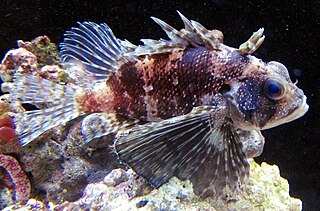
The red lionfish is a venomous coral reef fish in the family Scorpaenidae, order Scorpaeniformes. It is mainly native to the Indo-Pacific region, but has become an invasive species in the Caribbean Sea, as well as along the East Coast of the United States and East Mediterranean and also found in Brazil at Fernando de Noronha.

Dendrochirus biocellatus, the twospot turkeyfish, twinspot lionfish, twoeyed lionfish or ocellated lionfish, is a species of marine ray-finned fish belonging to the family Scorpaenidae, the scorpionfishes and lionfishes. This species is widespread throughout the tropical waters of the Indo-West Pacific region, In the wild, the species eats small fish as well as shrimp.

The clearfin lionfish, also called the tailbar lionfish, radiata lionfish, fireworks fish or radial firefish, is a carnivorous, ray-finned fish with venomous spines belonging to the family Scorpaenidae, the scorpionfishes and lionfishes. This species lives in the Indian and western Pacific Oceans. This is the only lionfish species which has spines without any markings. It can also be recognized by the pair of horizontal white stripes on its caudal peduncle.

Brachypterois is a genus of marine ray-finned fishes belonging to the family Scorpaenidae, the scorpionfishes. They are native to the Indian Ocean and the western Pacific Ocean.

Ebosia is a genus of marine ray-finned fishes belonging to the family Scorpaenidae, the scorpionfishes. They are known as falcate lionfishes. They are native to the Indian and Pacific Oceans.
Phenacoscorpius, the no-lined scorpionfishes, is a genus of marine ray-finned fish belonging to the family Scorpaenidae, the scorpionfishes. They are native to the western Atlantic, Pacific and Indian oceans.

Parapterois is a genus of marine ray-finned fishes belonging to the family Scorpaenidae, the scorpionfishes. These fish originate from marine environments in the Indian Ocean or near it. The venomous Parapterois heterura is occasionally seen as an aquarium fish.

Parapterois heterura, the blackfoot firefish, blackfoot firefish, blue-fin lionfish, black-Foot lionfish or gurnard lionfish, is a species of marine ray-finned fish belonging to the family Scorpaenidae, the scorpionfishes. It is widely distributed on the southeastern coast of Africa as well as off Japan and in Indonesia where it is usually found in sheltered coastal bays with a soft bottom, such as fine sand or mud. It is found in depths ranging from 40 to 300 metres. This species is a sedentary fish and may even bury itself within the substrate. P. heterura flashes its brightly colored pectoral fins to startle predators and escape, but it may also use these fins to corner prey. This behavior has been demonstrated in other lionfish. This species can be found in the aquarium trade.

Pterois miles, the devil firefish or common lionfish, is a species of ray-finned fish native to the western Indo-Pacific region. It is frequently confused with its close relative, the red lionfish. The scientific name is from Greek pteron, meaning "wing", and Latin miles, meaning "soldier".

Pterois antennata, the spotfin lionfish, banded lionfish, broadbarred lionfish, broadbarred firefish, raggedfinned firefish, raggedfinned scorpionfish or roughscaled lionfish, is a species of marine ray-finned fish belonging to the family Scorpaenidae, the scorpionfishes and lionfishes. It is found in the tropical Indian and Western Pacific Oceans.

Pterois mombasae, the African lionfish, deepwater firefish or frillfin turkeyfish, is a species of marine ray-finned fish belonging to the family Scorpaenidae, the scorpionfishes and lionfishes. It is found in the tropical Indian Ocean, typically in soft-bottomed areas of the ocean, often in conjunction with invertebrate growth. It grows to a maximum size of 20 cm, and is of moderate commercial value.

Dendrochirus brachypterus, the dwarf lionfish, short-finned turkeyfish, shortspine rockcod or shortspine scorpionfish, is a species of marine ray-finned fish belonging to the family Scorpaenidae, the scorpionfishes and lionfishes. It is found in the Indo-Pacific. It is sometimes found in the aquarium trade.

Dendrochirus barberi, the Hawaiian lionfish or green lionfish, is a species of marine ray-finned fish belonging to the family Scorpaenidae, the scorpionfishes and lionfishes. It occurs in the Eastern Central Pacific. It occasionally makes its way into the aquarium trade.

The Andover lionfish is a species of marine ray-finned fish belonging to the family Scorpaenidae, the scorpionfishes and lionfishes. It is found in the western Pacific Ocean.

Pterois sphex, the Hawaiian turkeyfish or Hawaiian lionfish is a species of ray-finned fish with venomous spines belonging to the family Scorpaenidae, the scorpionfishes and lionfishes. It is found in the eastern Central Pacific, specifically in marine waters off of Hawaii. It is found in seaward reefs and lagoons at depths from 3 – 122 m.

Pterois russelii, the largetail turkeyfish, plaintail firefish, plaintail turkeyfish, Russell's firefish, Russell's lionfish, spotless butterfly-cod or the spotless firefish, is a species of ray-finned fish with venomous spines belonging to the family Scorpaenidae, the scorpionfishes and lionfishes. It is native to the Indo-Pacific Ocean from the eastern part of Africa to the Persian Gulf.

Pterois brevipectoralis is a species of marine ray-finned fish belonging to the family Scorpaenidae, the scorpionfishes and lionfishes. This species is found in the Western Indian Ocean at a depth of 70 to 80 m.

The Luna lionfish, the dragon's beard fish or Japanese lionfish, is a species of marine ray-finned fish belonging to the family Scorpaenidae, which consists of scorpionfishes and lionfishes. It is found in the western Pacific Ocean.

Pterois cincta, the Red Sea lionfish or Red Sea clearfin lionfish, is a species of marine ray-finned fish belonging to the family Scorpaenidae, the scorpionfishes and lionfishes. It is found in the Red Sea.

Pterois paucispinula is a species of marine ray-finned fish belonging to the family Scorpaenidae, the scorpionfishes and lionfishes. It is found in the Western Pacific Ocean.
























